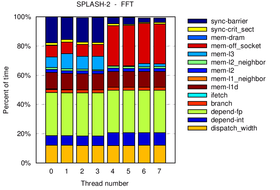Difference between revisions of "The Sniper Multi-Core Simulator"
| Line 57: | Line 57: | ||
Please send any questions or comments to: <code>snipersim [at] groups [dot] google [dot] com</code> . You can also visit our [http://groups.google.com/group/snipersim Google Groups] page to subscribe to the list and search through the archive of previous messages. | Please send any questions or comments to: <code>snipersim [at] groups [dot] google [dot] com</code> . You can also visit our [http://groups.google.com/group/snipersim Google Groups] page to subscribe to the list and search through the archive of previous messages. | ||
| − | === | + | === Team Members === |
* [http://www.elis.ugent.be/~tcarlson Trevor E. Carlson] | * [http://www.elis.ugent.be/~tcarlson Trevor E. Carlson] | ||
* [http://www.elis.ugent.be/~wheirman Wim Heirman] | * [http://www.elis.ugent.be/~wheirman Wim Heirman] | ||
Revision as of 02:16, 29 November 2011
At Ghent University and the Intel ExaScience Lab, we have been working on a next generation multi-threaded, high-speed and accurate simulator, called Sniper. This micro-architecture simulator is based on the interval core model and the Graphite simulation infrastructure, allowing for fast and accurate simulation and for trading off simulation speed for accuracy to allow a range of flexible simulation options when exploring different micro-architectures. Using this methodology, we are able to achieve good accuracy against hardware for 16-thread applications, with a speed of up to 2 MIPS.
The Sniper simulator allows one to perform timing simulations for multi-threaded, shared-memory applications with 10s to 100+ cores, at a high speed when compared to existing simulators. The main feature of the simulator is its core model which is based on the interval core model, a fast mechanistic core model. The interval model allows for faster simulations that typical cycle-accurate simulators by jumping past regions when the core is idle because of long latency operations.
This simulator, and the interval core model, is useful for uncore and system-level studies that require more detail than the typical one-IPC models. As an added benefit, the interval core model allows the generation of CPI stacks, which shows the number of cycles lost due to different characteristics of the system, like the cache hierarchy or branch predictor, to be easily understood.
Features

In addition to the main features mentioned above, we have updated the base simulation infrastructure to allow for simulating a larger set of workloads on more recent simulated hardware. Here is the full set of some of the recently added features:
- Interval core model
- CPI Stacks to gain insight into lost cycles
- Multithreaded, x86-64 support
- Validated against the Intel Core 2 micro-architecture
- Full DVFS support
- Shared and private caches
- Modern branch predictor
- OpenMP support
- Runs SPLASH-2, Rodinia, SPEC OpenMP and most of PARSEC
- SimAPI for changing the simulator's behavior at runtime
- Easy debugging of applications and the simulator
- Multiple Linux-OS support (Redhat/Debian/Ubuntu/etc.)
- Open source software, licensed under the MIT and Interval Academic License
- Additional features
You can find additional information on the simulator and its components in our recently accepted SC2011 paper [ pdf ].
Getting started
- Download the Sniper source code
- Follow the Getting Started instructions
Discussion list
Please send any questions or comments to: snipersim [at] groups [dot] google [dot] com . You can also visit our Google Groups page to subscribe to the list and search through the archive of previous messages.
Team Members
<meta name="keywords" content="Sniper Simulator,Sniper,simulator,computer architecture,micro-architecture,microarchitecture,ExaScience Lab,exascience,exascale,SC11,supercomputers,super-computing,computers,Gent University"/>